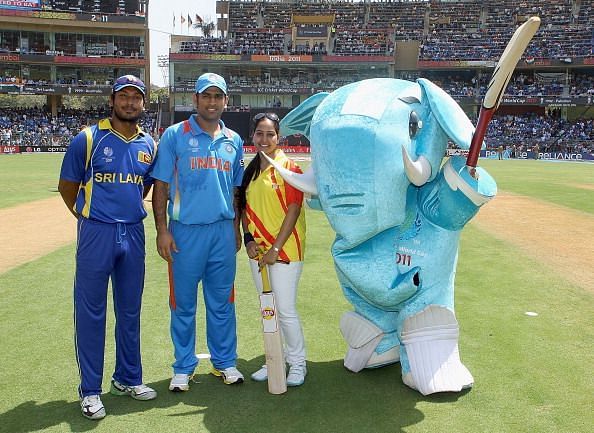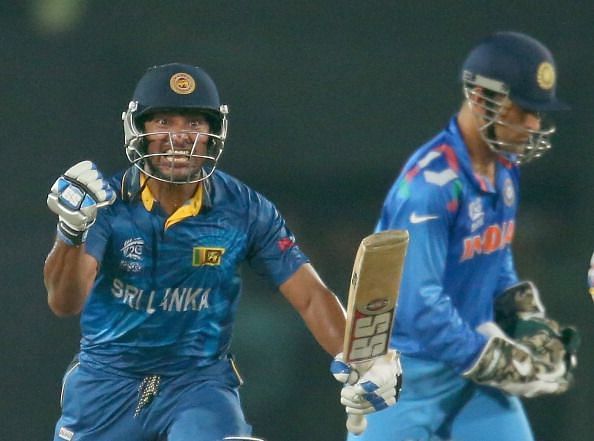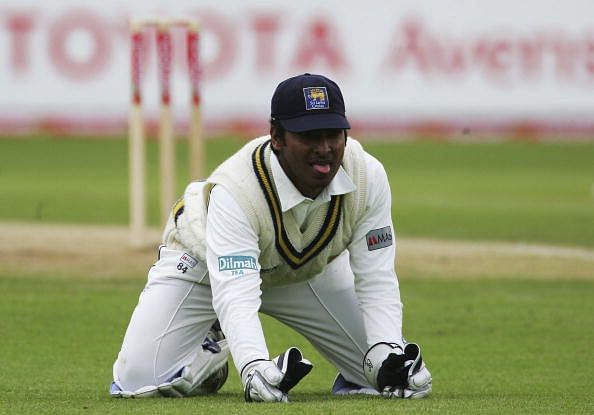
Player Comparisons: MS Dhoni vs Kumar Sangakkara

So, this new guy on the block walks out on the playing field like a warrior heading to battle. He has long and silky hair, the kind that would make even Bollywood actresses jealous. He comes on the pitch and wields his bat like the mace of Hanuman.
He shows fans a kind of fury that they have never witnessed before. While his bat raises a tempest against the bowlers – disfiguring the ball with the sheer force of the willow – his face exudes an uncanny level of calmness.
It is as though he is some sort of a cold-blooded serial killer like Hannibal Lecter that hacks down his victims without the slightest increase in blood pressure.
And then there is this other guy, a left-handed batsman, the complete antithesis of the first guy.
This bloke comes from an aristocratic family and his sophisticated batting is a reflection of that. He walks out on the pitch slowly and steadily, almost as though he is attempting to intimidate his opponents like a lion slowly moving just before pouncing on it prey.
He tickles the ball with his willow; it is so delicate that it feels sensual. He harnesses the ball as though he doesn’t want to hurt it, but just make love with it. At one point, when the ball reaches the fence, you could almost feel the ball longing to once again be in the bosoms of his bat.
These two players, of course, are MS Dhoni and Kumar Sangakkara.
The two couldn’t be any different from each other, and yet share striking similarities. They may have contrasting playing styles, but have a common ground in other aspects.
Overall ODI batting record

From Table 1, it can be inferred that it is really difficult to make a steady comparison among the two. While Dhoni may have a much better average, Sangakkara has a lot more runs. Also, the fact that comes in to bat late in the game means that he ends up with more not-outs under his name than the Sri Lankan did – which, in turn, helped the former India captain have a better average.
Even if you leave out the not-out factor, Sangakkara averages 37.46-per-innings while MS Dhoni reaches the figure of 37.24 – which, once again, brings us to the conclusion that the two could be labelled as equally good, statistically, in ODIs.
Against the big teams

The table above consists of the ODI records of these two players against the big teams that include Australia, England, South Africa, Pakistan, India and Sri Lanka.
While Pakistan and Sri Lanka might not be among the elites right now, they did have great teams at some point of these two players’ careers
In Table 2, it can be noticed that there is not really much difference between their career averages and the ones against the better teams.
The away factor

Sangakkara’s prowess lies in the way he carries himself on away grounds. These numbers are a proof as to how he improves on foreign conditions. While Dhoni’s numbers go down, Sangakkara’s increases. Without considering the not-outs, Sangakkara averages 37.89 per-innings and Dhoni some way behind at 35.16.
Prowess at chasing

Now let’s have a look at Table 4. Here, it might look like Dhoni has a significantly superior record to Sangakkara while chasing, but a deeper look will expose the little crevices of that thought. Once again leaving out the not-out factor, the former Sri Lanka captain averages 33.54 runs-per-innings, which is still higher than Dhoni’s 33.38 run-per-chases.
However, Dhoni’s ability to stay along while chasing is commendable; even if we consider Dhoni's lower-middle-order position.
The fact that Dhoni has more not-outs than his Sri Lankan counterpart despite playing fewer innings, proves that he could endure a lot of pressure that came whilst chasing a total.

This is where Dhoni is unprecedentedly better than the former Sri Lankan batsman. Just look at that average, not-outs and the strike-rate. The fact that Dhoni has played fewer innings and yet has more not-outs than his contemporary is a telling testament to his successful chasing prowess.
38 not-outs in 63 innings where India won the game while chasing. That’s a staggering 60% not-out rate in successful chases, which implies that he is a man that returns to the dressing room with the win more often than not.
Even if we omit the not-out factor while calculating averages, Dhoni makes 38.6 runs-per-successful-finishes, whereas Sangakkara is some way behind at 35.1 runs-per-successful chases – which reveals Dhoni's superiority in a convincing manner.
However, there is one underlying fact that should not be neglected: both their teams were heavily dependent on them while chasing a total.
If you compare the not-outs in Table 4 and Table 5, you will notice something astounding: Sri Lanka failed to win only thrice whenever Sangakkara finished the game undefeated, while Dhoni had to face the same dejection only twice.
In other words, Sri Lanka successfully completed an astonishing 88.8% of chases whenever Sangakkara came back to the dressing room without getting dismissed. And with Dhoni, the number goes to 94.7%. That's simply amazing.
Role in victories

From Table 6, it can be interpreted that the performances of these two were considerably better when their teams won. Actually, it is the other way around: their teams won more when they played well. While Dhoni’s average might make him look above and beyond Sangakkara, we should keep in mind that the man from Ranchi has many not-outs to help his numbers.
If the not-outs are kept out of the equation, then Sangakkara has an average of 41.3 runs-per-innings while Dhoni is only slightly above at 42.38 runs-per-innings. And these are really impressive numbers. Dhoni, however, got it at a quicker rate.
In conclusion, it is really difficult to pick out one from the two in ODIs given that their numbers are pretty similar in almost every aspect, but when it comes to chasing, Dhoni is marginally better – and a lot quicker.
Also, the fact that Dhoni batted a lot deeper than Sangakkara makes it all the more impressive for the Indian to be toe-to-toe in terms runs made in each innings (without considering not-outs while calculating).
Overall Test batting record

There is not much to say in this regard because it would be blasphemous to even attempt to make a case for Dhoni here. Sangakkara is above and beyond the former Chennai Super Kings captain and that’s nothing to be ashamed of because the Sri Lankan is among the elites when it comes to Test cricket.
Only Sir Garfield Sobers has a better average than Sangakkara among batsmen that have at least 8000 runs, only Sir Donald Bradman has more double hundreds (12) than Sangakkara and no player has more runs than him at number 3 – that's the legend of Sangakkara in Tests.
Performances against the big teams

Once again, performances against Australia, England, South Africa, Pakistan, India and Sri Lanka have been counted here.
As a result, as highlighted in the table above, both Dhoni and Sangakkara see a slight drop in their performances whilst playing against the big teams.
However, there is a twist here: Sangakkara’s average steeply drops even further to 43.73 when Pakistan is taken out of the equation while even Dhoni’s average goes down to 36.13 without counting the performances against the neighbouring country.
Seems like Pakistan is the team these two players love to play against.
But, truth be told, the Sri Lankan’s performances against the better teams is much better than Dhoni. Like, much, much better.
Roles in victories

Again, as Table 9 shows, both players average significantly better in their team’s victories, but Dhoni’s lower-middle order batting position gives him more chances to stay not-out than the number 3 specialist Sanga.
Leaving not-outs from the picture, Sanga averages a staggering 64.9 in Sri Lanka Test wins while Dhoni is far behind at 39.9. There was never really anything to debate here; Sangakkara is a far superior player in Tests – and only a very few come close.
The away factor

The table above further demonstrates the superiority of Sangakkara over Dhoni. The former India captain’s records away from home are very mediocre. In fact, he only has one Test century away from home – and that, too, on the subcontinent against Pakistan.
Sanga, meanwhile, is still a beast away from home. Indeed, his current form in the county is a testament as to how he adjusts himself to foreign conditions.
Overall captaincy record

Since both of these players have captained their respective nations, it is natural to compare this aspect as well. However, the Sri Lankan didn’t captain his side for many games, hence the comparison isn’t really fair towards the Indian. However, we shall do it just for the sake of it.


As Table 11 and Table 12, respectively, show, both Sangakkara’s and Dhoni’s performances improve as a captain, especially the former. However, Sangakkara didn’t play even 1/3 of the games that Dhoni did as a captain, which somewhat decreases the validity of the scenario.
Team performance under their command
The performances of their respective teams under the leadership of the two was quite good. However, as already mentioned above, Sangakkara didn’t really lead his side in many games for us to give a definite conclusion about his leadership. As a result, Dhoni has the upper hand.


The man from Ranchi is India’s most successful captain and the only ever captain in the history of the game to win three major ICC tournaments – the 2007 T20 World Cup, the 2011 World Cup and the 22013 Champions trophy.
Despite the claims that Dhoni’s record in Tests was below average – his away stats show that he was actually abysmal – he is the only ever Indian captain to lead his side to a rank 1 place in Tests. However, it can’t be denied that his captaincy record outside home was terrible. .
However, Sanga’s was even worse. The former Sri Lankan couldn’t lead his side to a single Test win away from home. His home record in Tests is much better, but still a far-cry from the achievements of Dhoni.
Meanwhile, Sri Lanka played some of the best cricket in the ODIs under his watch. His stats are better than the Indian in this regard – although he played a lot less games as captain – and Sri Lanka’s run to the final of the 2011 World Cup under his stewardship is a testament to his abilities as a leader in ODIs.
As a captain, however, Dhoni is far ahead of Sangakkara.
Wicketkeeping

And we shall conclude this long and elaborate comparison with the other common thing among the two: wicketkeeping.
Both of them are legendary keepers, but Sangakkara is edges Dhoni in terms of catches while the latter betters the Sri Lankan in stumping skills – which is actually pretty obvious to the eye given that we have witnessed Dhoni make so many lightning-fast stumpings from behind.
Statistically, Dhoni makes 0.33 stumpings every innings compared to Sangakkara’s 0.28 stumpings-per-innings. However, the Sri Lankan is way ahead of the Indian when it comes to catches with 1.1 catches-per-game to Dhoni’s 0.96 catches-per-game.
As a result, Sangakkara leads the way in terms of dismissals-per-innings with 1.365 when compared to Dhoni’s 1.288.
Conclusion
It is very difficult to choose one among these two. While Sangakkara is a better batsman – especially in Tests – Dhoni is a quality leader whose presence would benefit the team a lot. As a wicket-keeper, both are equally good, but Sangakkara is marginally better.
So here is a solution: let’s pick both!